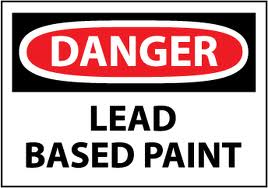Labor and Environmental Groups Bat for Greater Public Protection against Lead Exposure
Environmentalists have joined forces with trade unionists in a bid to provide greater protection for the workers, children and the general public against exposure to lead-based paints.
The common plea aired by the Associated Labor Unions-Trade Union Congress of the Philippines (ALU-TUCP), Bukluran ng Manggagawang Pilipino (BMP), NAGKAISA Labor Coalition and the EcoWaste Coalition coincided with the 91st anniversary of an International Labor Organization (ILO) convention banning the use of white lead in painting that entered into force on August 31, 1923.
C013, or the White Lead (Painting) Convention, is considered a historic act by the ILO during the time of the League of Nations (the precursor to the United Nations) to control lead levels in paint used on interior areas of housing.
C013, among other provisions, prohibits “the use of white lead and sulphate of lead and of all products containing these pigments, in the internal painting of buildings,” but makes it “permissible to use white pigments containing a maximum of 2 per cent of lead.”
“ILO’s early recognition of the problem with toxic lead in paint was a commendable move indeed. Their effort resulted on a number of countries adopting restrictions on the lead content of paint. As the C013’s 91st anniversary of its entry into force is quietly observed, we find it fitting to call for a review of the landmark agreement for it to be in step with the global consensus to eliminate lead paints that is being advanced by the UN-backed Global Alliance to Eliminate Lead Paint (GAELP),” said Aileen Lucero, Coordinator, EcoWaste Coalition.
The World Health Organization and the United Nations Environment Program serve as joint Secretariat for GAELP whose purpose is “to prevent children’s exposure to lead via paints containing lead and to minimize occupational exposures to lead in paint.”
“To get the review process initiated by the ILO’s Governing Board, we urge our government through the Department of Labor and Employment to make the necessary representation and action,” said Josua Mata,Co-Convenor of NAGKAISA, the country’s biggest labor coalition composed of BMP, TUCP, Federation of Free Workers, National Confederation of Labor, Partido ng Manggagawa, Sentro ng mga Nagkakaisa at Progresibong Manggagawa and other workers’ organizations.
“It’s been over nine decades since C013 entered into force and lead poisoning via exposure to lead contaminated paint chips, dust as well as products such as toys remains a huge threat for the health of children and workers in many countries,” said Allan Tanjusay, Spokesman and Policy Advocacy Officer, ALU-TUCP.
“An updated Convention will surely bring in more measures that will protect paint industry workers and painters from lead exposure,” stated Gie Relova, Secretary-General, BMP National Capital Region.
According to the labor and environmental groups, C013 has to be updated to make it applicable to all lead pigments and dryers, ready-to-use paints, as well as to exterior applications.
They also insisted that the 2% limit, which is equivalent to 20,000 parts per million, has to be radically lowered to mirror current knowledge of the health effects of lead exposure even at lower levels.
An updated C013 will be a boost to the recently promulgated “Chemical Control Order for Lead and Lead Compounds” (CCO) issued by the Department of Environment and Natural Resources in the Philippines last December2013, the groups said.
The CCO limits lead in paints at 90 ppm and further establishes a three-year phaseout period for leaded decorative paints (2013-2016) and a six-year phaseout period for leaded industrial paints (2013-2019).
The CCO also provides for “regular basic awareness, knowledge and training of employees and industrial users for appropriate work practices to minimize the creation and exposure to lead hazards during production or on the risks and hazard potentials involved in the storage, handling, use, manufacture, transport and/or disposal of generated wastes of lead and lead compounds.”
Citing data from the Asia Regional Paint Report published last March 2014 by IPEN with support from the European Union, 76% of the 803 paint samples from the Philippines and six other Asian countries contained lead at concentrations greater than 90 ppm, and would not be permitted for sale in most highly industrialized countries.
In addition, at least a quarter of the said 803 paint samples contained dangerously high lead levels above 10,000 ppm.
-end-
References:
C013:
http://www.ilo.org/dyn/normlex/en/f?p=NORMLEXPUB:12100:0::NO::P12100_ILO_CODE:C013
CCO for Lead and Lead Compounds:
server2.denr.gov.ph/uploads/rmdd/dao-2013-24.pdf
Asia Regional Paint Report:
ipen.org/sites/.../Asia%20Regional%20Paint%20Report%20final.pdf
Notes:
EcoWaste Coalition, launched in 2000, is a public interest network of 150 groups from various sectors and regions promoting sustainable and just solutions to waste, climate and chemical issues. It is running a “Lead Paint Elimination Project” with support from the European Union and IPEN, a global civil society network for a toxics-free future.
ALU, founded in 1954, champions the ideals of free trade unionism. It is affiliated with the TUCP, the biggest confederation of labor federations in the Philippines, and with four global union federations, including the Building and Wood Workers International (BWI).
BMP (Solidarity of Filipino Workers), formed in 1993, is a political labor center, composed of socialist, militant and democratic organizations of the working class, from both the formal and informal sector. It is a member of the World Federation of Trade Unions (WFTU) and International Center for Labor Solidarity (ICLS).
NAGKAISA, established in 2011, is a multi-ideological and multiform network of labor organizations, consisting of over 50 labor centers, federations and national unions.






Comments